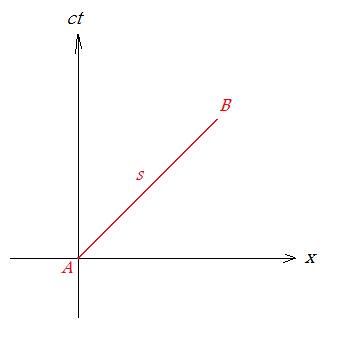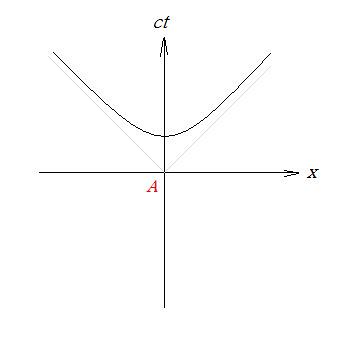- This topic has 16 replies, 10 voices, and was last updated 13 years ago by TheFlyingOx.
-
Confused, of Edinburgh [warning: theoretical/particle physics content]
-
TheFlyingOxFull MemberPosted 13 years ago
I’m currently reading a book that is supposed to make particle physics accessible to the lay-person: “Why Does E=mc²?”
I’m OK with the light-clock experiment: in the book it uses the example of a light-clock on a moving train, with the moving light-clock ticking slower from the viewpoint of someone on a platform watching the train rush by than it does from the viewpoint of someone sat on the train with the clock. I get the Pythagorean maths required to understand this.
What has baffled me is how the book has then gone on to explain distances in spacetime using Pythagorus. I get that the distance in spacetime between one event and another, s, must be universally agreed upon for a particular event, but that actual time and space between the two events will vary depending on the speed of the observer relative to the events. The book shows that in trying to determine s, using Occam’s Razor it’s best to start at the simplest possible explanation and add bits as are required until the theory works. It therefore starts with 2d Euclidean space and Pythagorus’ Theorum to try and work out s, with time x speed of light (ct) vs distance (x). It states that if we are using Occam’s Razor and Pythagorus, then s² = ct² + x² or s² = ct² – x².
Where does the second equation come from? That’s not Pythagorus. I’m fine with pulling equations out of the air and testing them to see if they’re correct or not, but what…? What leap of logic is required to equate Pythagorus to s² = ct² + x² and s² = ct² – x²?
If I could understand where the second equation came from then I could get on with the rest of the book, but at the moment my brain hurts. Anyone either read it or is a physics boffin and can enlighten me?
luked2Free MemberPosted 13 years agos² = ct² + x²
That looks wrong to me. The units are all wrong.
s² is in metres-squared, whereas ct² is in metre-seconds surely?
Or is it just too early in the morning for my brain to function properly?
bassspineFree MemberPosted 13 years agos is in metres and that value is squared, not the same as metres squared
pypdjlFree MemberPosted 13 years agoNo, it’s dimensionally correct, (speed*time)^2 gives metres squared.
TheFlyingOxFull MemberPosted 13 years agoForgetting all the units, the book is trying to tell me that Pythagoras is both z² = x² + y² and z² = x² – y².
That’s what I don’t get. How is the second equation arrived at? If I could understand why z² can be calculated from either equation, I’d be on my way.
TheFlyingOxFull MemberPosted 13 years agoOh, and for the pedants, it’s actually s² = (ct)² + x² or s² = (ct)² – x²
simonralli2Free MemberPosted 13 years agoI think the only decent quote about quantum physics is that if you think you have understood it you obviously don’t 🙂 Good luck. And remember there are many different interpretations of what the mathematics of quantum physics is tellings us about the underlying ultimate ground of reality 😯
TiRedFull MemberPosted 13 years agoWhilst time is a dimension, unlike space, its invariance from reference frame to reference frame is handled slightly differently. Normal spatial dimensions x,y in 2D do obey normal pythagorus hence the x^2+y^2 is a constant. Unfortunately, time is not the same as a spatial dimension and it requires the negative sign.
By analogy for E = mc^2;
Energy is not conserved, but energy-momentum – the combination is conserved. I once asked my tutor where the energy went in a doppler shifted photon goes and she looked at me blankly:<Physics bit>
Energy (E) = Planks constant x frequency,
So if frequency goes down, energy is lostMomentum (p) = planks constant x c/wavelength
C = frequency x wavelengthWhat is actually conserved is Energy-momentum = E – pc^2
</Physics bit>Note the negative sign. The energy will fall as the momentum increases. It’s also true for particles with mass, but in our world things travel so slowly we don’t see the deviation from the simple conservation law.
Hope this helps
TheFlyingOxFull MemberPosted 13 years agoTo give you an idea of what I’m struggling with, I’ve spent 5 minutes doodling in MSPaint:
‘s’ is what I’m trying to work out, the distance between point A and point B. As mentioned before, s must be a fixed immutable distance. x is a distance in 3d space, ct is the time, ‘t’, elapsed between starting at point A and arriving at point B multiplied by the speed of light, ‘c’. Note that no distance need be covered between A and B, in which case ‘B’ would be straight up on the ‘ct’ axis.Apparently, substituting these values into Pythagoras gives us s² = (ct)² + x² or s² = (ct)² – x².
The correct Pythagorus equation makes sense to someone used to normal geometry, and gives us:
This makes sense at first glance. As long as ‘s’ stays the same, which it has to, then B can be anywhere on the circle. However, this would suggest that B can happen before A (bottom half of the circle) and this is impossible due to causality.The book then tosses correct Pythagoras aside and substitutes the other one, giving:
Again, B can be anywhere on the curved line, and this time can never happen before A. The problem I now have is that the distance between A and B is ‘s’ and therefore no way is ‘s’ the same length for all values of ‘x’ and ‘ct’.
ellipticFree MemberPosted 13 years agoThe problem you really have is that s is actually a “metric” not a “distance”.
This is a term that mathematicians (and physicists) use as a kind of generalisation of the concept of “distance” which can be applied to different kinds of geometry from our usual 3-D space. 4-D spacetime is a good example of one of those. Just calling it “distance” is easier to get across in a book for lay readers but also confusing when you try and understand it more deeply.
When you try to visualise 4-D spacetime relationships in normal 2-D or 3-D you just have to accept that the normal concept of “distance” doesn’t quite work here, and believe what the maths tells you instead. After a while you do start to develop some intuition about it… but it can take a while 🙂
TheFlyingOxFull MemberPosted 13 years agoOK, so I get I’m not supposed to be thinking about things in normal 2d or 3d. I guess that will come with time. this is probably why the book is taling about the shortest distance between two points not being a straight line – eg London to Tokyo is an arc over the Earth’s surface.
I’m still stuck though. Where does the -ve version of Pythagoras come from? I’m not cool with a book supposedly bringing physics to the masses (badum, tcshhh) just springing random equations at me and telling me to accept it with no explanation. Can someone give me an idea how the -ve Pythagoras is derived and why it should be used rather than the +ve one? I’ve never come across it until this book, so it’s a totally new concept to me.
funkynickFull MemberPosted 13 years agoHave a looky here…
http://quantumrelativity.calsci.com/Relativity/Chapter3.html
The paragraph about 3 or 4 down is where it starts talking about distance..
JeromeFree MemberPosted 13 years agoI have a degree in Physics, but am clueless here.
Thus I have been failed by the education system..ellipticFree MemberPosted 13 years agoCan someone give me an idea how the -ve Pythagoras is derived and why it should be used rather than the +ve one?
Simple but unsatisfying answer: that’s just the way it is, mmmkay? 😉
More detailed (but still rather handwavy) version:-
So the key ideas of relativity are (a) any reference frame of coordinates is as good as any other even if they’re moving differently (but not accelerating); and (b) the speed of light is always measured the same in any reference frame.
Taking these two conditions together is enough to derive the Lorentz Transforms, which are the equations that convert time/space coordinates from one reference frame to another. These are the equations with all the factors of sqrt(1 – v^2/c^2) in them. And when you use the Lorentz Transforms, ordinary intervals-in-time and distances-in-space don’t stay the same: instead you get time dilation and length contraction.
The next question is: can we find a combined space/time metric which *is* conserved by the Lorentz Transforms?
And the answer is: yes, it’s the modified version of Pythagoras which you’re having trouble with.
This can all be verified with A-level algebra but has much deeper expressions in full-on differential geometry (way out of our depth here).
Another way of looking at it which might help… or might not… is that the “time” coordinate in the geometry of spacetime carries a hidden factor of “i” the square root of -1. Time is not just another dimension like space: it’s genuinely different and can’t be mixed up with them in quite the same way. This is reflected in the metric where squaring it then comes out as “minus” rather than “plus”.
The topic ‘Confused, of Edinburgh [warning: theoretical/particle physics content]’ is closed to new replies.



